Beans, beans, the musical … I’ll stop now. Ahem … I’m an adult. Right.
Hello! How are you? Do you love beans? Beans as a main, beans as a side, beans in chili, beans in everything? Me too! They’re a vegetarian’s best friend, but they’re everyone’s best friend, too. Chock full of satiating protein and filling fiber … beans are good stuff. 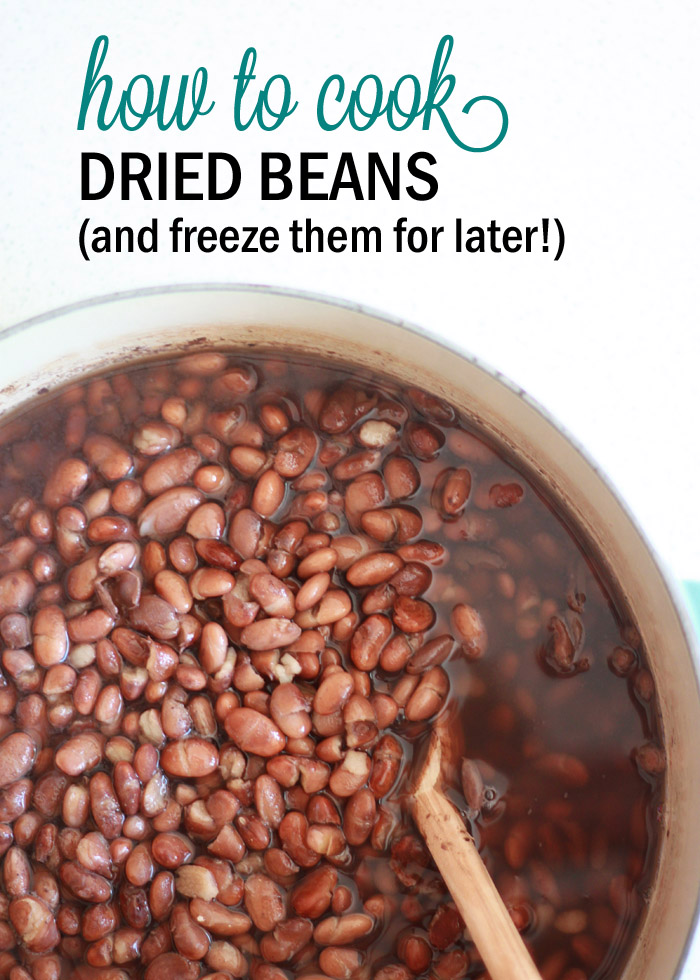
Most recipes these days call for beans by the 15-ounce can, but it really pains me to pay for canned beans when I know that I can save a ton of money by buying dried beans, cooking them at home myself, and freezing them for later. It makes me feel all virtuous when I grab a 2-cup bag of beans from the freezer instead of opening a can that cost me way more. 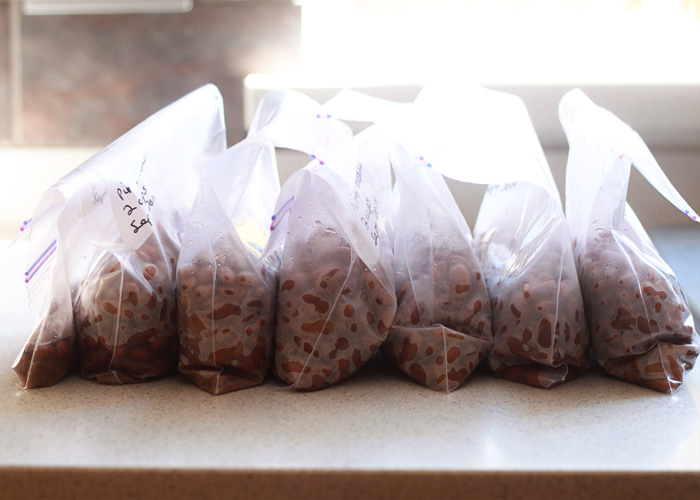
How much money will I save by doing this, you ask? A ton!
Do you get excited when you find your favorite brand of shoes (in the color you want! and your size!!) for 60% off? Me too! So I love cooking my own dried beans from scratch, because when I do it this way, I save about 55-60% over buying canned. And that’s a conservative estimate.
I had a whole paragraph about the math, but it was way too crazy involved. In a nutshell: If you prepare a pound of pinto beans that cost you $1.99, it should equate to paying about 65 cents per 15-ounce can. A great deal, right?!
You might also wonder: Will my beans taste better? Well, honestly, I go back and forth on this. They don’t necessarily taste better than canned, but there’s something … fresher … about beans prepared at home. Of course, that could be all in my mind. Plus, you control the sodium content, which is nice.
If you’re new to the cooking beans game, you might be thinking, “dude, this is not worth all the work!” Well, I promise it’s not much hands-on – maybe 20 minutes total. And once you get a rhythm down, you’ll be whizzing through the process – the perfect side-project for a weekend day or when you have half a day or so to just putter around the house.
Okay! Let’s do this! There are five steps to cooking dried beans and freezing them for later.
- Get prepped
- Rinse and sort through the dried beans
- Soak your beans
- Cook your beans
- Bag and freeze
Here’s the breakdown:
Get prepped
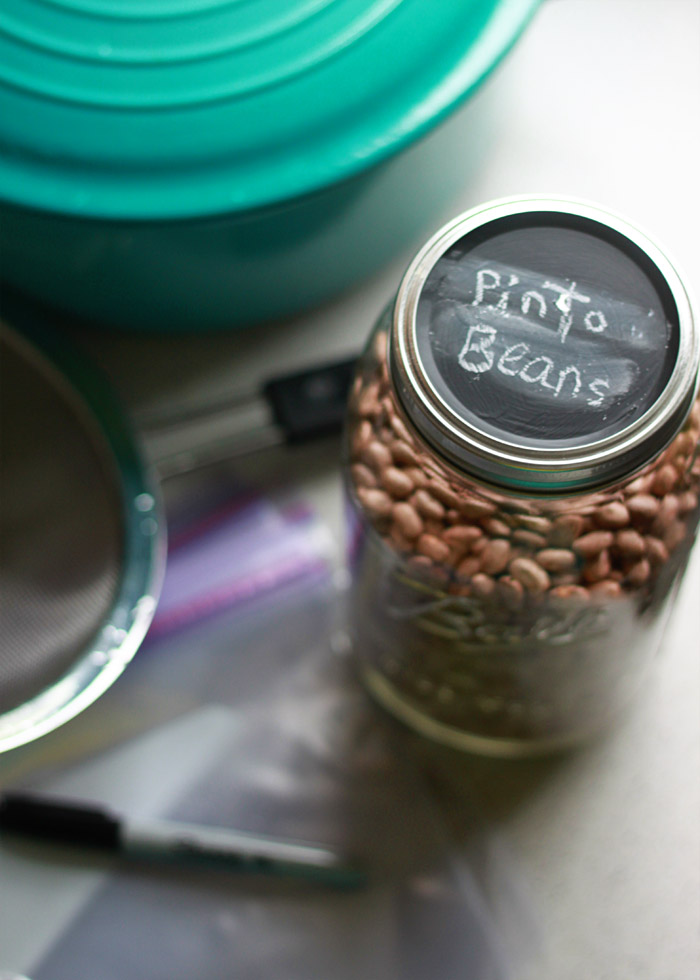
To get started, you’ll need:
-
- Time. Cooking dried beans takes some time from beginning to end, but most of that is hands-off. Depending on your soaking method (more about that below), you want to plan ahead. For the overnight process, you’re looking at about 12 hours from beginning to end. Quick soak, more like three. I usually reserve the bean-cooking for when I know I’m going to be hanging at home for much of the day.
- Dried beans. You can buy them by the bag at most grocery stores, or I like to grab organic beans from the bulk section of well-stocked grocery stores like Whole Foods. I most often stock up on common varieties like black beans, white navy beans, cannellinis, red kidney beans, and pinto beans.
- A large pot. I cook two pounds of beans at a time in a 7 1/4 quart pot, and it’s just barely big enough.
- A large colander or large sturdy sieve. Small holes (smaller than your beans!) and as roomy as possible.
- Freezer bags and a sharpie. Because nothing’s worse than mystery freezer food that’s not labeled!
Rinse and sort through the dried beans
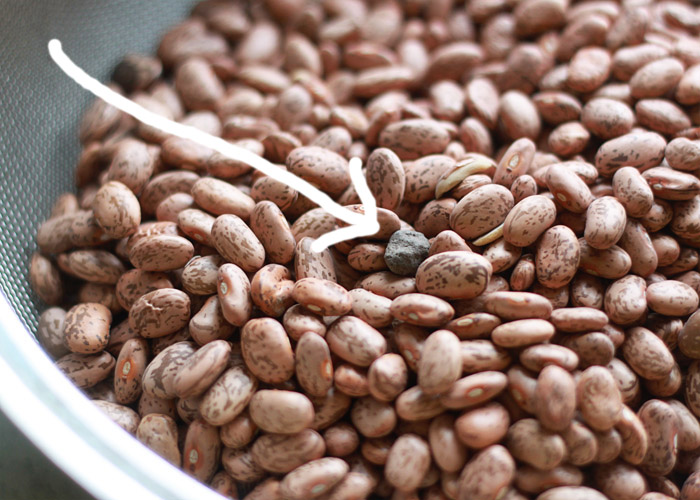
Put the beans in a large colander, a few at a time, and pick through them. See any weird bits and pieces? Discard them. It doesn’t happen all the time, but debris like rock or clumps of dirt can definitely be present, so inspect those beans carefully! Also discard badly broken beans or shriveled bits while you’re at it. Rinse, swish, and look through them again. 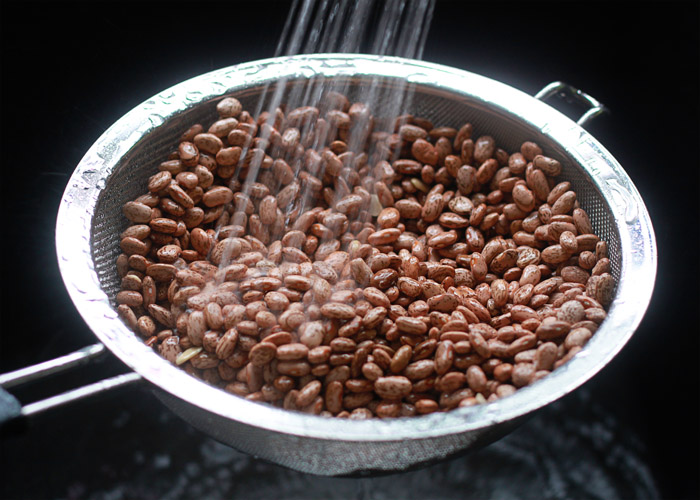
I then flick them into the soaking and cooking pot, a few at a time, checking the beans carefully one last time. A little insurance that I didn’t miss anything. 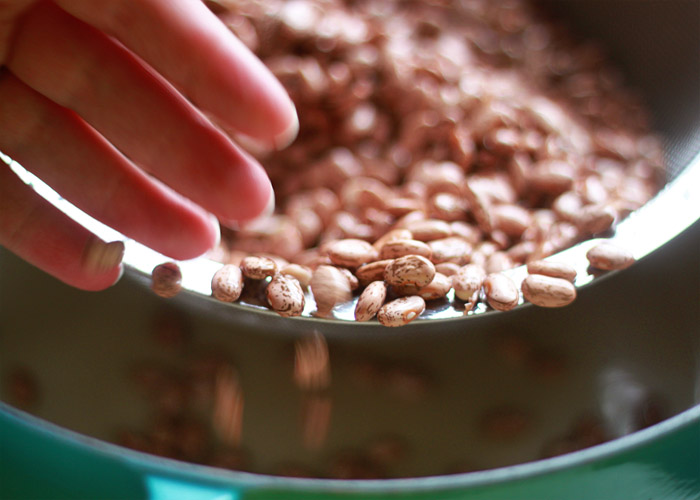
Soak your beans
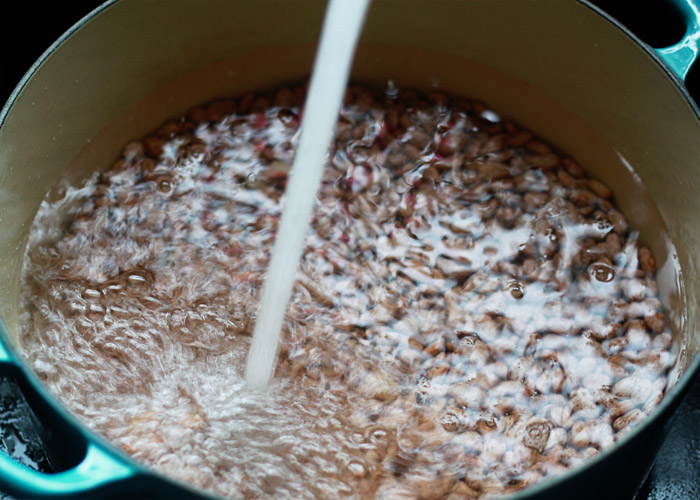
First off, a question that’s often asked: Do I need to soak my beans? My answer is yes! That is, unless you want righteous gas (hey, sometimes it’s important to be blunt.) Soaking the beans (and then discarding that gas-laden soaking water) helps get rid of flatulence-causing compounds. Plus, especially with harder beans, it helps them to cook faster. Both good reasons to soak those beans!
So how do you soak them? Let me count the ways. Okay, there are two. They both start with placing the rinsed and sorted beans into the pot and then filling the pot with water to about two inches above the beans. And then choose your soaking method:
Overnight Soak
I usually do an overnight soak – it’s just less fussy to fill the bean-filled pot with water and let it sit overnight. Then all you do is drain, rinse, and cook.
Quick Soak
As the name indicates, this is a faster way to soak your beans. Place your beans and water on the stove over high heat. Bring to a boil and boil for 2-3 minutes. remove the pot from heat and cover. Let sit for 1 hour then proceed.
Cook your beans
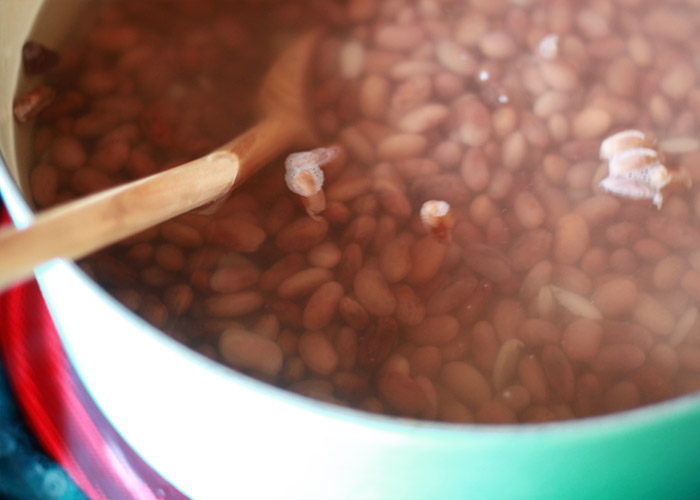
Drain the soaking water, rinse and swish the soaked beans, and drain again. I use the colander or sieve for this.
And now it’s time to cook! Add fresh water to the pot of soaked beans, to about two inches above the top of the beans. I don’t season the beans. I used to add a hefty pinch of salt and a glug of olive oil which gave the beans great flavor, but they would cook up mushier. I didn’t like that. So now I just go for straight-up beans – maybe a bay leaf if I’m feeling fancy. Strangely, the common thought is that salt will make the beans tough, but I didn’t experience that. Just mushiness.
Place the pot over high heat and bring to a boil. As soon as it comes to a boil, give the beans a stir and reduce the heat to right around medium-low until you find the right temp to maintain a simmer. Cover beans, leaving the lid partially askew to help a bit of the steam to escape.
Cook the beans for anywhere from 30 – 60 minutes or possibly even more, depending on how tough your variety is, until tender. Depending on the type of bean, they may cook fast (such as navy beans) or they may take longer (such as kidney beans). A special note on kidney beans, by the way: Make sure they’re cooked through! Raw and undercooked kidney beans contain a toxin that can cause gastric issues, so cook them well!
My favorite way to tell the beans are done? Use a slotted spoon to scoop a few out and blow on the beans. If the skin peels and curls up, your beans should be cooked. Try one to be sure!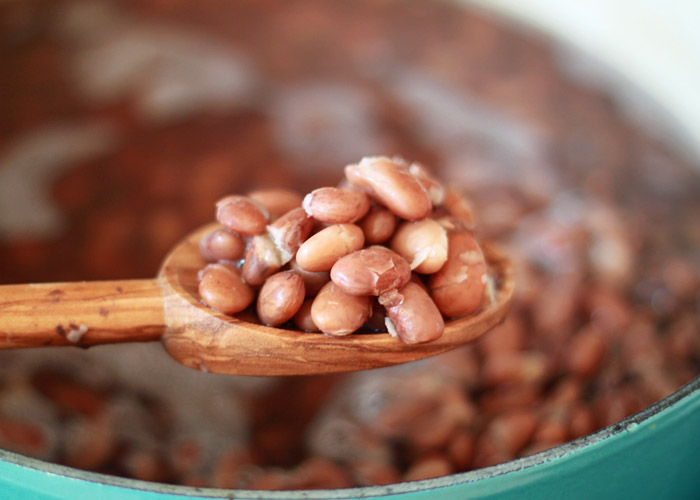
Once the beans are cooked, uncover them and remove them from the heat. Let them cool. 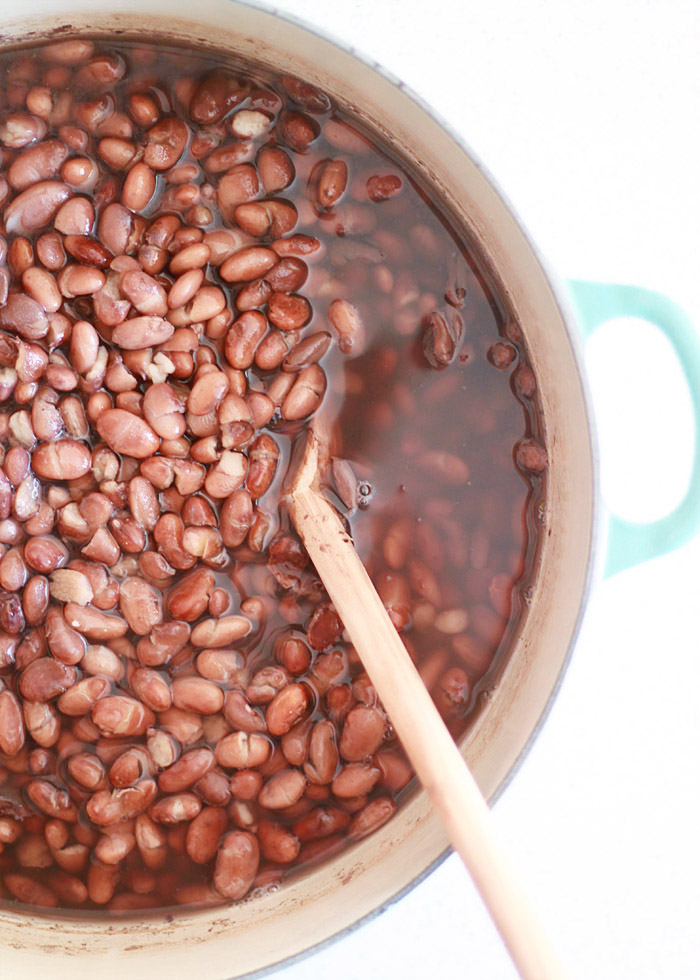
Freeze and bag your beans
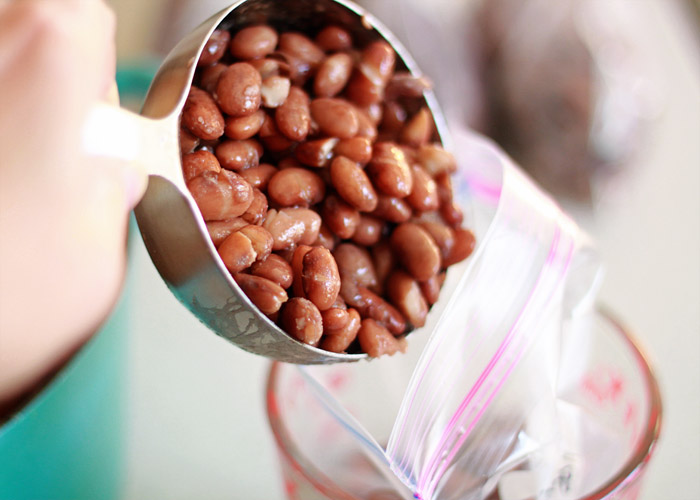
Once cool, drain the cooking water from the beans. Some people like saving the bean broth for other uses like soups.
Label several freezer-safe zipper bags with a permanent marker like a Sharpie – I list the variety, quantity, and date.
I then set the bag in a small bowl or 2-cup liquid measuring cup and measure the beans into each by the cupful. I freeze in two-cup increments – roughly the same amount as a can of beans – so I can do the one-for-one thing when cooking up recipes. One bag = one can.
Okay! You’re done! Now transfer your beans to the freezer, and you’re all set. They should keep up to six months. 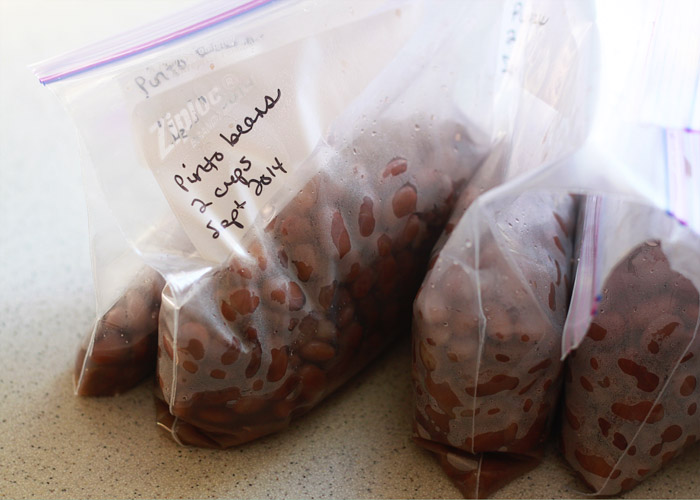
I pull the beans out of the freezer and add them to hot recipes – like chili or beans and rice – frozen, right out of the bag. But for recipes where I need to start with thawed beans, I’ll pull them out the night before and let them thaw in the fridge, or place the sealed bag in a large bowl of warm water to quick-thaw.
Cool beans!
Resources
I’ve cooked beans plenty enough to feel confident writing this post, but I wanted to be sure I was right, so I fact-checked at these two sites (which, by the way, are great references if you want to learn more): The Bean Institute and Whole Foods Food Guide for Beans
If you try this recipe, please leave a rating! And, if you find it share-worthy – which I hope you do – please share. Tag #kitchentreaty on Instagram, Facebook, or Pinterest, and don’t forget to check out my other recipes!
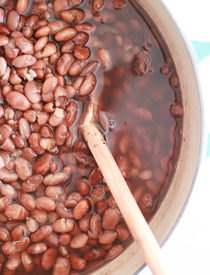
How to Cook Dried Beans and Freeze Them For Later
Ingredients
- 2 pounds beans
- Water
Equipment:
Equipment
- Very large pot (7 quarts or larger)
- Large colander or sieve
- Freezer-safe zipper bags
- Sharpie permanent marker
Instructions
- Rinse and sort through the dried beans. Put the beans in a large colander, a few at a time, and pick through them. Discard any weird bits and pieces like rock, clumps of dirt, badly broken beans or shriveled bits. Rinse, swish, and look through them again. Flick them into the soaking and cooking pot, a few at a time, checking the beans carefully one last time.
- Place the rinsed and sorted beans into the pot and fill with water to about two inches above the beans. Either cover and let sit overnight to soak, or, to do the quick soak method, place your beans and water on the stove over high heat. Bring to a boil and boil for 2-3 minutes. Remove the pot from heat and cover. Let sit for 1 hour.
- Drain the soaking water, rinse and swish the soaked beans, and drain again.
- Add fresh water to the pot of soaked beans, to about two inches above the top of the beans. Place the pot over high heat and bring to a boil. Reduce heat to a simmer and partially cover beans.
- Cook the beans until tender and the skins peel when you blow on them, 30 - 60 minutes, depending on the type of bean. If you're cooking kidney beans, cook them well! Raw or undercooked kidney beans can be toxic.
- Remove from heat, uncover, and let cool.
- Once cool, drain the cooking water. Label your freezer bags and scoop beans into bags. Seal and transfer to freezer until ready to use in your cooking, just like you would a drained can of beans. Beans keep in the freezer for about 6 months.
- To use, just add frozen beans directly to recipes like chili or beans and rice. They'll thaw right in the pot or pan. For recipes where you need to start with thawed beans, pull them out the night before and let them thaw in the fridge, or place the sealed bag in a large bowl of warm water to quick-thaw.


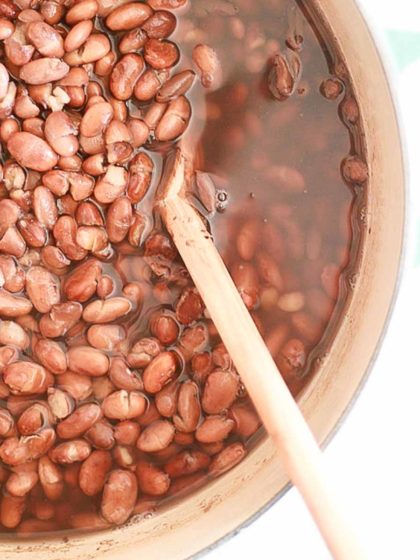
 I’m so glad you’re here! I’m a vegetarian home cook, certified plant-based pro, and mom. I’m married to an enthusiastic carnivore, and my mission is to achieve peace in the kitchen – one tasty recipe at a time. These days, with a name like mine, I also try not to ask to speak to the manager.
I’m so glad you’re here! I’m a vegetarian home cook, certified plant-based pro, and mom. I’m married to an enthusiastic carnivore, and my mission is to achieve peace in the kitchen – one tasty recipe at a time. These days, with a name like mine, I also try not to ask to speak to the manager.
Wonderful tutorial! I haven’t made beans at home in a few years – I need to get better about that because you are right, you save so much! Love that you freeze yours – that makes them just as convenient as canned!! Thanks for sharing
Thanks Sam!
We have been using dried beans in our house for the last several years. I used to cook them like you do on the stovetop – and I still do sometimes in the winter to warm the house up! – but now I normally throw them in the crockpot on high after soaking them and let them cook all day. I’ve also read about pressure canning uncooked dry beans but I haven’t tried it yet because I have much more freezer space than I do pantry space.
Slow cookers – is there anything they can’t do?! Love ’em. 🙂
Even better – dehydrate those cooked beans and vacuum seal them in bags or jars, and they’ll last for 25 years or more! They become instant beans you can put into soups, or just add water to for any dish. I especially love instant black beans for tortilla soup, so I cook at least 2 pounds at a time, dehydrate them and store in vacuum sealed Food Saver bags. Pre-cooking and rinsing mostly gets rid of the gas-forming elements and the black liquid from black beans, too, which is undesirable for any dish. You can turn long-cooking rice into instant rice by the same method as well. It is critical to give some types of beans a 5 minute hard boil, so putting them directly into a crock pot in their pre-cooked state is not advised. Precooking and dehydrating will take care of that. No freezer space needed when you have a dehydrator!
Wow, this is brilliant! Love it. Thanks Barbara!
. . . Why cook them in the first place?
I’ve been making chickpeas, pinto beans, and black beans in a crockpot. Similar steps, you’re just able to put them in and turn the thing on. It takes longer, of course, but then you don’t have to check it as often.
And I meant to ask, do you just freeze them as shown in the picture? I’ve been putting a couple of cups of beans in a small bag, and then put several small bags into a bigger one, and still feel like they’re not properly sealed or something. Ice seems to get into the small bags.
Hi Karen! This is a great reminder for me to DO this! It does save money over time and better yet, I can support my local farmer who grows various heirloom varieties! Now, I just need to get that second freezer… or a dehydrator (thank you Barbara!). Thank you, Karen! Great tutorial and resources!
What a great post, Karen! I never do this because I’m lazy. But I totally need to start. Thanks for all the wonderful tips!
I’ve admittedly fallen back into the habit of buying canned beans. My attempts at cooking dried beans have been less than stellar, especially chickpeas. Buuuut this post has inspired me to give it another go! I have
a pound of pinto beans soaking right now. 😀
I have ALWAYS frozen my cooked beans. I also freeze chili and spaghetti sauce and all kinds of soup.
YES! I need to prep dried beans in abundance for all my chili tailgating this football season. Slash the coming winter months. Slash because beans are the magical fruit. Fresher is an excellent word to describe dried versus canned! And fresher always tastes better to me. Epic tutorial, my dear! Just epic.
Wow. Great tutorial! I do this on a regular basis. I cook and freeze pinto, red, black, white beans, and lentils. I use them for quesadillas, burritos, tacos, soups, chili, etc. I soak mine all day and then cook in the crock pot on low heat overnight. I turn the crock pot off when I wake up and they are cool enough to bag and freeze around lunchtime.
Yeah! I’m all about batch cooking dried beans and freezing them. Those little individual portions in the freezer are the perfect thing for just tossing into soups, stews, smoothies (yeah, I put beans in my smoothies) what have you. Great post!
Greetings Karen,
Wonderful article!!
You write like I think, this I can do
Very thoroughly written! Thanks for the freezing bean info…
I no longer soak my beans- I find it makes them mushier and less tasty. I cook them in a pressure cooker, instead, and add a little bit of kombu (a sea vegetable) which cuts down on the gassiness. It’s much faster and less labor intensive.
Great post! One question, I always have with recipes that require “over night” soaks or rises is how much time is “over night.” I never know whether it’s 8 hours or 12 hours (or 6 hours now that I’m a parent of a young child, ha.) Do you have a suggestion? Thanks!
Thanks for this post! I’ve started a new diet for my dogs (Dr. Harvey’s Canine Health) where you mix in your own fresh proteins. I’ve never cooked beans before and I was nervous about doing it wrong for them. The instructions on the package are so abbreviated – I didn’t even know what it meant to sort them. Plus since it is so much work I wanted to know if I could freeze them without any trouble. Your blog helped a ton!
How do the beans taste in a salad after they’ve been frozen?! I often put chickpeas or black beans (canned) into my salads but I’m worried about the texture after they’ve been frozen! Perfect timing for me to see this post, I bought a bag on black beans on a whim yesterday, so this will be helpful!
I honestly don’t notice any difference from canned, once they’ve thawed!
Great post, thanks!!
This may be pushing it, but… after you have used the frozen beans in a hot meal, can you freeze and reheat? I often make big batches of veggie chili and freeze single portions for instance.
That’s a great question, I’m sure you’ve heard as I have that you should only freeze things once! I guess I can’t absolutely 100% say that you can do it and you will be totally fine but I can tell you that I’ve frozen chili made from frozen beans and I’m still here to talk about it. 🙂
CAN YOU FREEZE BEANS IF YOU HAVE MADE A TOO LARGE POT AND THEY ARE ALREADY WELL SEASONED FOR DINNER? I ALWAYS MAKE EXTRA BECAUSE A LARGE POT OF BEANS JUST SEEMS BETTER.
I freeze leftover beans all the time! So nice to just pull them out for a quick and easy meal.
Great explanation!! I’ve just turned vegan and want to add more beans and grains to my diet. My question is…If I use a crock pot instead of a pot on the stove, how long should I cook them?
I’ll be honest, I’ve had mixed success with cooking beans in the Crock Pot! I just tried cooking black beans yesterday and had to transfer them to the stove in order for them to be done in time. Here are a couple of links that might help: http://www.kalynskitchen.com/2010/12/how-to-cook-dried-beans-in-crockpot.html | http://www.thekitchn.com/how-to-cook-beans-in-the-slow-cooker-74529
Alicia Lee,
I made black beans in a slow cooker twice now and here is what I’ve learned from reading a LOT of blogs, like this one and The Kitchn. Last time I made them , it was successful. My crockpot has a timer, so I left it on overnight for eight hours. In the morning when I checked on them, they were soft (but not too soft) and cooked. I didn’t presoak, so if you do I think the time will vary (maybe 4-6 hours instead of 8).
If you are seasoning yours before you freeze, stick to aromatics only (garlic, onion, chilis) until the beans have softened/cooked. The first time I made crockpot beans they never softened. I cooked them longer than overnight — probably like around 15 hours or more — and they never got that creamy, beany texture. I researched why, and I realized that the fact that the tomatoes I added to the crockpot were the culprit. Sugar and acid (both naturally found in tomatoes) will keep your beans from getting soft.
I am freezing them pot liquor and all in bags. I can’t tell you yet how they reheat, but I’ll let you know.
Kare, thank you for this. I may use this method next time I freeze beans.
I do almost the same when I can mine lay out on table after rinsing and pick through, quick soak on high to a boil for 10-15 min covered, drain rinse,, put in pan high boil for 30 min, add beans to jars juice to cover, add 1Tbs to a qt and 1/2 tsp to pint’s wipe rim, add hot lids and rings tighten to a firm hold not to tight, using a pressure canner at 15 lb’s for qt’s and pints, 1hr. 15 min’s
for qt’s and 1hr for pint’s 1hr , take out of canner after it cools down a an set on towels until cool if not sealed put in refrig.
The instructions are easy to follow , great information. Thank you. All of the side editorials were extremely irritating. I thought the page would never end.
Thanks for this easy tutorial! I usually make mine in the crockpot, but I like your approach too. As a vegetarian, you should have more than one option on how to get your beans! After I make all these beans, I usually make a dozen or so bean burritos and freeze them in wax paper for easy meals later on. 🙂
This is a great post! Dried beans can be healthier than canned as well. Dried beans can be no sodium based on how you cook them, unlike there canned counter parts. We get our canned beans from http://www.palousebrand.com.
opps sorry everyone http://www.palousebrand.com We really love this company we can field trace right to where our beans were grown! They provide great customer service and they are Non-GMO!
I had a problem with beans not cooking to a soft consistency. I finally found out why this was happening Do not add the salt until the end of the cook. Once I did that my beans came out fabulous. Do you add your salt at the end?
Hi! I was wondering if you ever froze beans in reusable containers, or if you re-use your freezing bags. I hate the thought of putting so much plastic in the garbage but when I freeze in small plastic containers, I get a lot of ice crystals. Didn’t know if you had any tips on that end. Thanks!
I plan on freezing in mason jars. The secret is to lay whatever you want to freeze (beans, cut fruit, chicken, etc.) in a single layer on a cookie sheet in your freezer and let them all freeze individually. Then just pour into your mason jar. If you just put the beans in a mason jar and freeze it I suspect you will have a mushy clump of beans when you try to defrost it.
This is exactly the information that I was searching for. Your images are a beautiful bonus. Thank you for making my search so easy. Currently cooking the magical fruit on my stove top.
– Kelly
This is great way to cook beans. And be sure to look for the rocks often.
I just found one the other day! 🙂 Thanks Nora.
!oh I love the mason jar’s lid. I’m sure you get that a lot!!
Thank you so much for this info! I just cooked my beans, as described, and am waiting for them to cool. I would have paid $12+ for the beans that I got for a little over $2 and a little time. Thanks for the encouragement to simplify and save!
Thank you for making this tutorial! I have a whole bunch of dried beans at home and have been cooking them in small batches for specific meals. Talk about a long process for one recipe! This makes much more sense. I think I will try to use empty small yogurt containers (the 500ML variety) to store the beans. That way I can reuse the containers too instead of using plastic bags. Thanks again!
Great idea for storing them – I need to try that!
Karen: What is wrong with adding onion and garlic to the beans, cooking them and then freezing them? Is it just a matter of preference or perhaps the effects of freezing on spices and herbs? Thanks a lot. Joe
Another good reason over canned and premade is that the containers they are stored in once cooked whether plastic or metal is treated with a resin to stop the dried product from being contaminated but is self defeating because those chemicals are leaching into the cooked product. However when the food is dried it is near impossible to penetrate and thus it cannot be contaminated.
Thank you. I bought 2 pounds of black beans on a whim and had no clue as to what to do with them. This is the perfect prep I was looking for.
Pls how can I preserve dry blended beans for long.
Is there a way to cook dry beans so they don’t fall apart? I have thrown away so many beans that look like the ones in your pictures. I thought I was just a bad cook. Is that how they are supposed to come out?
The beans in my pics are probably a bit overcooked, but still fine in my opinion! If you’re concerned about them falling apart just check them sooner. A telltale test is to remove a bean from the cooking liquid and blow on it. If the skin peels back they are cooked.
I’m using an instant pot now, so checking sooner isn’t possible. I didn’t cook them long enough and set it to cook two minutes longer, but it takes 8 minutes or so to come up to pressure and it was too much. I’m also thinking the beans at the supermarket are just too old. Do you know where online I could find some of better quality?
The beans are fresher – and you get much more variety – if you shop for heirloom beans like Rancho Gordo. https://www.ranchogordo.com/collections/heirloom-beans or Elegant Beans .
Soak them in salty water instead and they will stay together much better.
https://www.seriouseats.com/2016/09/salt-beans-cooking-soaking-water-good-or-bad.html
My daughter will be having baby soon and I would like to cook lots of different beans and freeze. How long can she keep the beans frozen?
If i store the beans in the fridge or freezer do i need to reheat it before eating?
Hi there,
What about freezing beans with the liquid? I have an awesome pinto bean recipe that turns out like a soup, the “broth” is really delicious. Pouring it down the drain would be a waste. Do you think freezing it with the liquid would be a bad idea? Thanks.
Nah, that should work fine – good point!
I’d just been instructed by my health coach that adding beans to my salad was a good way to pump up the protein. He suggested using low sodium canned but I countered I’d rather cook my own and freeze them I just needed to go online for tips. Today I am going to do this with2 lbs of black beans.
Thank you so much for posting this. I am wondering if adding some salt is a good idea though. But will do first batch without.
Thanks again.
Salt can actually hinder the beans’ ability to cook! I don’t understand the science behind it, just that it can make them take longer – so better to add salt after. 🙂 Enjoy!
Terrific, My first bean-cook and I should have gone to your site, so now I can store them and hopefully enjoy my first bean-cook and I printed out your recipe, so I’ll do it properly the next time. Thank you.
I love this way for soaking, cooking, and freezing beans. So handy and fresh. Way better than canned beans.
I have for years used the method you describe to cook and freeze pinto beans. I became bored with the blandness of the beans so I took the suggestion of a Hispanic friend and added two Serrano peppers , cut finely along with a large yellow onion and more recently a large sweet potato cut in bite size chunks. Add all of these raw after the beans are done while still hot on the burner. Keep the lid on and let it all steep for several hours. The onion , sweet potato and Serrano’s cook in the hot beans. The result is a slightly sweet and spicey juice partially absorbed by the pintos. This freezes well in Zip locks. If you add too much salt the sweetness will disappear. I let guests salt to their taste with their portions. This works well with black beans too.
That sounds amazing! I need to try that. Thank you so much for sharing.
I would like to know your thought on phytic acid in beans. I’ve read to soak for 24 hrs to leach it out of the beans. Sometimes I soak them longer depending on if I get too busy to get to them.
I appreciate your article on freezing beans. My daughter put beans on to soak for me – I now have a 5 qt pot FULL of beans when I only needed one quart.
I was wondering if these chickpeas taste good cold for salads? Will the texture be off when they are cold? I also wanted to make my own hummus
The first time I ever made Hummus from beans I had done from scratch, I could not get it to taste like I thought hummus was supposed to taste. Surprise, I had never had hummus that had not come premade.
Now I prefer my own.
I tend to cook my beans (for freezing) slightly firmer than I eat them so that they can add them to recipes and they can simmer and absorb the flavors of the dish.
thanks for the tutorial and links.
Great idea on cooking your beans al dente. I’ll need to try that! Thanks Susan!
When I soak my black beans they turn purple. How do I keep them black?